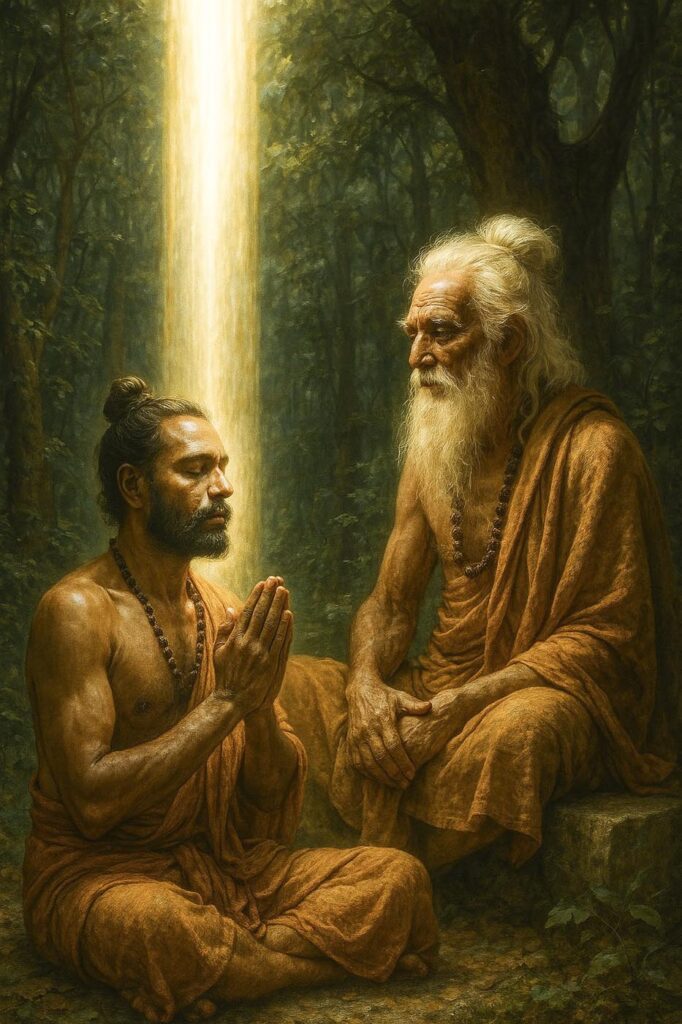A Sacred Teaching on Identity, Reality and Liberation
The following is an excerpt from S. Radhakrishnan’s translation of the Paingala Upanishad, Chapter 3, sections 1–6, edited for length and clarity
In a gathering of teacher and disciple, the sage Yajnavalkya imparts the wisdom of the Self to his devoted student, Paingala, revealing the essence of non-duality and ultimate liberation.
Paingala asked, “O revered teacher, please explain in detail the great teachings that lead to liberation.” 1
Yajnavalkya replied: “One should meditate on the truth of ‘That Thou Art’ and ‘I am Brahman.’ In this context, ‘That’ refers to the unseen, all-knowing divine being—endowed with the power of maya and existing as pure being, consciousness and bliss—the very source of the universe. ‘Thou’ refers to the individual self, shaped by personal experience and identified with the sense of ‘I.’ When the veiling power of maya and ignorance is removed, the Supreme and the individual self are realized as one and the same—Brahman, which is not separate from the true Self.
“Inquiry into the meaning of the great sayings, such as ‘That Thou Art’ and ‘I am Brahman,’ is known as hearing (shravana). Focusing intently on the meaning of what is heard is reflection (manana). Fixing the mind with one-pointed concentration on what is realized through hearing and reflection is meditation (nididhyasana). When meditation becomes completely absorbed in its object—when there is no distinction between the meditator, meditation and the object of meditation—the mind becomes steady, like a flame undisturbed by wind. In this state, the Self is not perceived as an external object but is realized inwardly, as direct knowledge beyond the reach of the senses.
“With this realization, the accumulated karma from countless past lives dissolves. As the practice deepens, an unceasing stream of spiritual nectar flows from all directions. Because of this, accomplished yogis refer to this highest realization as ‘the cloud of virtue’ (dharma-megha-samadhi). When all past impressions—both good and bad—are completely dissolved, and karma is extinguished at its very root, the direct perception of Brahman occurs as clearly as one sees an amalaka fruit held in their hand. At this stage, the realized being is jivanmukta, liberated while still embodied. 2
“Ishvara, the Supreme Lord, wished to reverse the process of creation. He withdrew the universe back into its subtle causal state, causing all elements and forms—macrocosms, microcosms, bodies, senses and the mind—to dissolve into their original essence. One by one, earth dissolves into water, water into fire, fire into air, air into space, space into self-awareness, self-awareness into the first cosmic manifestation “the great principle” (mahat), mahat into the unmanifest, and the unmanifest into the Supreme Self.
“At the cosmic level, Virat (the manifested universe), Hiranyagarbha (the cosmic mind) and Ishvara (the supreme controller) dissolve into the Absolute. At the individual level, as the effects of past karma come to an end, the physical body merges into the subtle (astral) body, the subtle body into the causal (soul) body, and ultimately, the causal body merges into the unchanging Self. Likewise, the three states of waking, dreaming and deep sleep dissolve into the inner Self. When the microcosm is purified by the fire of knowledge, it merges into the Supreme.
“Thus, the seeker, having attained self-restraint, should meditate without ceasing on the identity of ‘That’ and ‘Thou.’ As ignorance dissipates, just as the sun shines in full brilliance when the clouds clear, the Self is revealed. The enlightened one perceives the Self, shining in the heart, like a steady, smokeless flame inside a lamp. 3
“One should meditate upon the unchanging, eternal reality that manifests all things. A sage who remains engaged in this meditation, uninterrupted—until sleep overtakes him or he departs from this world—is truly established in the Self. 4
“Such a realized being, liberated while still in the body, is blessed and has fulfilled all duties. When the time comes to leave the body, he enters into videha-mukti (disembodied liberation), just as air becomes still when it ceases to move. 5
“He transcends all sensory experience—beyond sound, touch, form, decay, taste and smell—eternal, without beginning or end, beyond even the great principles of creation. In that final state, only the flawless, unchanging, and ever-pure Reality remains.” 6
Sarvapelli Radakrishnan, (1888-1975) was an Indian philosopher and statesman, India’s first vice president (1952–1962) and second president (1962–1967). He held doctorates in science, philosophy and theology.

Advaitha Vedanta best path to self realisation.. needed in modern times at end of Kaliyuga…..Shankaracharya… Recent master Siddharameswar Maharaj